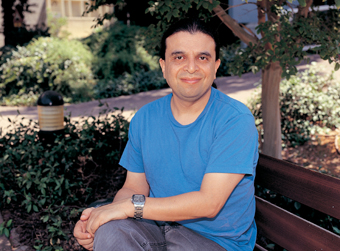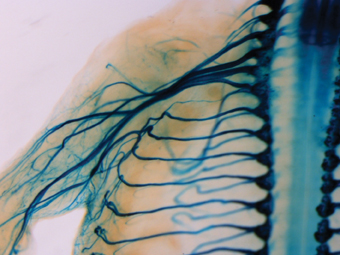עיתונאיות ועיתונאים, הירשמו כאן להודעות לעיתונות שלנו
הירשמו לניוזלטר החודשי שלנו:

It’s an electrical engineer’s nightmare: a complex “wiring system” of nerve fibers that connects more than 100 billion nerve cells in the brain to one another and to the rest of the nervous system. These nerve fibers, called axons, are often up to several feet in length, and they must grow out to their targets bit by bit, making their way through surrounding tissues and around a myriad of obstacles. How do the growing axons find their intended connection without getting lost along the way?
Dr. Avraham Yaron of the Biological Chemistry Department is trying to elucidate the mechanisms that guarantee the proper wiring of these billions of nerve cells during the development of the fetal nervous system. Such discoveries could one day lead to ways of alleviating or curing ailments tied to nerve fiber injury or wiring defects.
Over the past decade, it’s become clear that growing axons are guided by a sort of biological “GPS system.” It’s not satellite signals that help the axons navigate their way around the nervous system, however, but chemical guidance cues. These cues can work in two ways to ensure that the axons “take the right road”: Their signals can be attractive – like neon lights luring the axons toward the right target; or they can be repellent – acting as “roadblocks” to prevent axons from making a wrong turn. Scientists have already described several major families of guidance molecules, each of which seems to work in a different way. But little is known about the way this elaborate chemical guidance system actually operates.
Yaron mainly researches the guidance of sensory axons – those nerve extensions that transmit sensations of pain, heat and touch from the skin to the brain. These axons are guided in their development by an important family of guidance cues, the semaphorins. However, just as in GPS systems, it appears that axons need a “receiver” to detect the guidance signals. The axons’ receivers are protein receptors located on their outer surface.
During his postdoctoral studies, Yaron had identified two members of the family of sensory axon receptors – the plexin family – which are essential for receiving the signals from the semaphorins. Now, in his lab in the Weizmann Institute, he seeks to further clarify how signals are transmitted through these receptors. He also aims to identify new guidance cues and investigate how all the different cues are integrated.
To do this, Yaron and his team employ two complementary approaches. In the first, conducted in lab cultures, they can manipulate and expose the axons to different guidance cues, observing their effects at a basic level. They also use mouse models, in which they try to validate their in vitro results, as well as controlling various additional factors to analyze the behavior of axons in a more complex, real-life setting. So far, preliminary results suggest that the semaphorin guidance cues and plexin receptors work together to transmit repelling signals. This is evident from the scientists’ observations that in the presence of the receptor, the axons grow in stereotypical fashion toward their correct targets, but when the scientists knock out the receptor genes, effectively removing the roadblock, the axons lose their way and grow in all different directions.
One particular project in Yaron’s lab has clinical relevance: It focuses on diabetes neuropathy. In people with diabetes, as well as some cancer patients treated with chemotherapy, sensing axons may become disconnected from their targets, leading to severe pain in the extremities. Yaron is trying to discover whether the developmental guidance molecules might play a role in these pathological conditions. If this is indeed the case, understanding how they work could provide a novel solution to these conditions, for which there is currently no effective treatment.
Recent evidence suggests that chemical guidance cues play a role in many additional processes – for example, in the growth of new blood vessels, cell migration in the immune system and cancer. Thus, in addition to addressing significant basic research questions on axon guidance, Yaron’s discoveries could also yield insights in many other fields of biology.

Born in Jerusalem, Dr. Avraham Yaron earned a B.Sc. in biology from the Hebrew University of Jerusalem in 1993. He then went on directly to a Ph.D. program in the Hebrew University-Hadassah School of Medicine Department of Immunology and received his degree in 1999. “Ever since childhood, I have always been interested in science, yet it was only during my Ph.D. that it became absolutely clear to me that I wanted to pursue science as a career and have my own lab,” says Yaron. His Ph.D. thesis earned him the 2000 Amersham/Pharmacia Biotech prize for young scientists awarded by Science magazine. Yaron then conducted postdoctoral studies in the laboratory of Prof. Marc Tessier-Lavigne at the University of California, San Francisco, where he was first introduced to research on the mechanisms of axon guidance and made his discovery of the plexin receptors. Yaron joined the Weizmann Institute as a senior scientist in 2006.
Dr. Avraham Yaron’s research is supported by the Nella and Leon Benoziyo Center for Neurosciences; the Estelle Funk Foundation President’s Fund for Biomedical Research; the Dr. Ernst Nathan Fund for Biomedical Research; the Robert Rees Applied Research Fund; and the Henry S. and Anne S. Reich Research Fund for Mental Health.